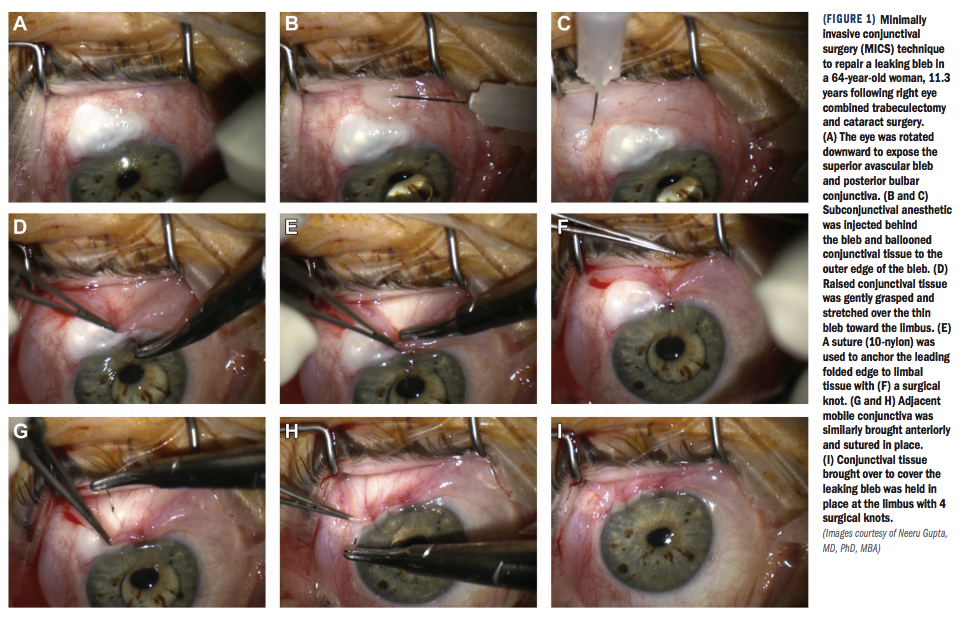Article
Bleb leaks treated with minimally invasive conjunctival surgery
Author(s):

Injecting lidocaine and stretching conjunctiva over it to tie and anchor into sclera offers a simple and safe procedure for treating bleb leaks, a complication of trabeculectomy.
Bleb leaks are a complication of trabeculectomy that occur despite improved success rates with local application of mitomycin C. Neeru Gupta, MD, PhD, MBA, shared her useful and simple approach for dealing with bleb leaks.
Dr. Gupta is the chief of Glaucoma and professor and Dorothy Pitts Chair, Departments of Ophthalmology and Vision Sciences and director, glaucoma research at the Keenan Research Centre for Biomedical Science, Li Ka Shing Knowledge Institute of St. Michael’s Hospital, Unity Health Toronto, University of Toronto.
Bleb leaks can occur after trabeculectomy with mitomycin C in the conjunctival epithelial surface. The affected area can be seen under high-power microscopy to have a minute microscopic break in the epithelial that is sufficient to cause a bleb leak.
Related: Bleb leaks and infections require vigilance
“The bleb leak has dogged ophthalmologists for some time. Our biggest fear is the ticking time bomb of potential infection,” Dr. Gupta said. “The break allows pathogens to enter the eye, which can lead to endophthalmitis and loss of the eye.”
In addition to this risk, serious structural abnormalities can accompany leaking fluid and hypotony. Corneal striae, shallow anterior chambers, fluid build-up through the choroidals, and hypotony maculopathy also can develop, she pointed out, that can result in loss of vision.
Managing bleb leaks
In the presence of a small bleb leak, Dr. Gupta prefers a conservative approach that includes an antibiotic to prevent infection and reduction of any topical steroids.
She also reviewed the use of other methods that have been tried, with varying success.
Pressure patches apply selective and focal pressure on the bleb and include the original Simmons tamponade shell, which also applies focal pressure to the leak, bandage lenses that cover the eye, self-dissolving collagen shields, cyanoacrylate tissue glue, autologous blood injections into the bleb to stimulate fibrosis and seal the leak, and argon or Nd:Yag laser to seal the leak, which can be associated with burns and large fenestrations of the conjunctiva.
Related: Researchers eye cure, diagnostics for adenoviral conjunctivitis
“We are constantly looking for new methods because of the varying success rates with these options,” she said.
Microsurgical approaches include resuturing of the bleb early in the postoperative period.
However, Dr. Gupta pointed out, the classic technique to treat a delayed-onset, avascular leaky bleb that develops after application of mitomycin C is excision of the bleb via multiple approaches.
Approaches to covering this area are multiple and include conjunctival advancement, creation of a conjunctival pedicle flap that is sutured to the area, amniotic membrane transplantation, buccal mucosal transplantation, and corneal patch grafts to cover the desired area. Other types of graft approaches have included fascia lata and scleral patch grafts.
Related: Physicians share surgical pearls for successful trabeculectomy
An incision-free approach
Dr. Gupta described the minimally invasive conjunctival surgical procedure that she uses to treat bleb leaks. She reported her results in 14 eyes of 13 patients, 12 of whom had open-angle glaucoma and one iridocorneal endothelial syndrome (Am J Ophthalmol. 2019;207, published online ahead of print Nov 2019).
The pre-operative range was seven months to 16.3 years after trabeculectomy with mitomycin C. Upon presentation with a leak, the mean IOP was 4.5 ± 2.8 mmHg.
Although the general approach would be to excise the bleb and create a conjunctival flap to cover the area, as mentioned previously, Dr. Gupta devised a procedure in which she injected subconjunctival lidocaine and stretched the tissue over the leaking area, which then was anchored to the limbus.
“The outcomes were very good in this consecutive series of patients,” she said. “The IOPs were stable at 12.3 ± 3.0 mmHg and the bleb leaks resolved in all cases immediately after the procedure. No further glaucoma medications or glaucoma surgeries were needed.”
The follow-up periods ranged from two weeks to five years. In one patient, the leak recurred two years after the procedure.”
“The next time you are faced with a bleb leak, consider injecting lidocaine and stretching adjacent conjunctiva over it to tie and anchor into sclera,” Dr. Gupta concluded.
Read more by Lynda Charters
Neeru Gupta, MD, PhD, MBA
E: neeru.gupta@unityhealth.to
Dr. Gupta has no financial disclosures related to this report.
References:
Trattler WB, Majmudar PA, Donnenfeld ED, McDonald MB, Stonecipher KG, Goldberg DF. The Prospective Health Assessment of Cataract Patients’ Ocular Surface (PHACO) study: the effect of dry eye. Clin Ophthalmol. 2017;7(11):1423-1430.
Newsletter
Don’t miss out—get Ophthalmology Times updates on the latest clinical advancements and expert interviews, straight to your inbox.




